Evaluating how students or employees are doing is key to keeping progress on track. Regularly checking both their successes and areas for improvement helps you see if your methods are still working for them. But do you have enough time to think this through? Do you sometimes feel tired or biased when making these evaluations? How do you handle your responsibilities at school or work? Does having too many tasks make it hard for you to fairly assess and grade your students or team?
This article opens up a different approach in grading, so much easier now to assess your students or trainees. Now you have all different options available on online learning platforms to your support. These systems not only facilitate the process of grading but also reduce the possible occurrence of human error and prejudice. You’ll automate the process of assessment, be guaranteed consistency and fairness in evaluations, and free time to really hone in on the more strategic areas of teaching or managing. Use of these advanced tools balances workloads, ensures timely, accurate feedback, and better supports students or your team.
- Why Choose An Automatic Grading System?
- History of AI Grading Evolution
- How to Select The Best Auto-grading System?
- Quick Overview of The 8 Best Automatic Grading Systems
- 8 Automatic Grading Systems for Teachers
- How to Create An Automatic Grading Exam with OnlineExamMaker?
Why Choose An Automatic Grading System?
Choosing an automatic grading system can significantly enhance efficiency and consistency in educational settings. These systems handle large volumes of assessments “rapidly”, allowing educators to spend more time on interactive teaching and student support. By applying uniform criteria to every student’s work, automatic grading reduces the risk of bias and inconsistencies that can happen in manual grading. Immediate feedback also helps students understand their performance quickly, fostering a more responsive learning environment.
Choosing an automatic grading system offers several advantages that can greatly enhance the educational process. Here, an automatic grading system is deemed to have a number of advantages that will make the educational process even more effective. Here are the eight most necessary reasons:
Speed
Automatic grading systems can quickly evaluate a large number of assignments for teachers and students. Rapid feedback delivery is of great importance to the learning process.
Consistency
Automatic systems apply the same criteria uniformly to all submitted assignments. This consistency removes all prejudices and grades in a just and objective manner.
Scalability
It will run effectively when many students provide a given class or an institution with many students. They can grade tens of thousands of student tasks and assignments without causing more straining and costing impacts.
Detailed Feedback
Sophisticated software systems are able to give a more detailed description of how the student performed and thereby identify what the good areas are and where the student is lagging behind. It may also be broader compared to what traditional feedback may offer manually.
Cost-Effectiveness
The administrative costs in testing can be substantially reduced by automated grading systems, as their use reduces the number of human graders needed. This would be especially useful in large settings with many students.
Adaptability
Modern systems can be devised to cope with multiple-choice, short answer, and essay types of questions in the assessment. Moreover, they can adapt to suit different rubrics and standards applied in the process.
Data analytics
Automatic grading systems often come with built-in tools that assist educators in keeping track of trends in student performance, hence pointing out areas the students were most likely struggling with. This ensures that interventions are targeted in such a data-driven approach.
Reduced Bias and Errors
Automated systems would, therefore, cut down on the level of human error and subjective biases involved in grading. In this way, every student is evaluated according to the given criteria and standards.

History of AI Grading Evolution
The history of automated grading systems dates back to the formative period of educational technology. In fact, though in simple forms, it began with machine-based grading methods in the beginning and middle of the 20th century. Early systems used punch cards or optical mark recognition (OMR) technology to automatically score multiple-choice exams. These systems, innovative for their time, were in turn restrained in capability, focusing on an objective assessment and the need for manual setup and maintenance.
The automatic grading systems have come a long way from those early days in which they started as very simple tools to become some advanced AI technologies. Early grading systems were predominantly based on such simple methods as bubble sheets. These are sheets where students would answer questions by shading or filling in circles. These sheets would then be scanned and graded using simplistic algorithms capable of grading only multiple-choice answers.
With the tremendous advances in artificial intelligence and machine learning over the past several decades, automatic grading systems have also transformed into much more complicated and diverse forms of assessments. Modern AI systems can now grade short- or even long-answer questions or other forms of exercises up to an increasing level of difficulty in evaluation, like programming assignments. These systems can use deep learning natural language processing to assess content more effectively and at length, with detailed feedback that provides personalized insights. At large, the trends represent changes toward educational tools that are AI-integrated in nature, thereby increasing scalability with increased accuracy in grading and concurrently continuously improving its ability to grade more nuanced parts of student works.
As technology moved forward, so too did the grading system. The computer programs incorporated, therefore made it possible to do more complex evaluations, such as short-answer questions. In these systems, the checking of answers is done with keyword matching. Different students may write the same answer in different words. The checking is limited. On the whole, though there were apparent limitations in these cases, they were a giant leap from manual grading.
The advancement that has taken place in this regard in recent years is known as artificial intelligence (AI). Modern AI systems can understand and assess even sophisticated student responses, such as essays, because they can make meaning from language, both its content and its context, and can even appreciate creativity. These super systems utilize machine learning to enhance their gradation accuracy through time, which results in the ability of the grader to be more responsive and fairer in their judgments over previous generations. It is a great improvement in terms of creating educational tools that will be more effective and personalized.
How to Select The Best Auto-grading System?
Selecting the best automated evaluation system includes examining several critical criteria toward making clear that it fits your needs and learning goals.
First, you must look at how compatible it is with the current curriculum and what it is exactly assessing. Look for a system that supports the kinds of assignments that are used—whether they be multiple choice, essays, or programming tasks. Make sure that the system’s algorithms and grading criteria are up to edifying standards and will offer an accurate, fair evaluation.
The software UI should be friendly enough for both a teacher and a student to conduct smooth implementation and interaction. And the ability of the system to provide actionable feedback and insights.
A grading system that goes beyond the measurement of student performance to give analytic detail of learning trends and areas for improvement will allow the educator to adapt methods of instruction to be able to reach out to more students. Also, determine the scalability and reliability of the systems, along with support options, on issues like data security and privacy.
Quick Overview of The 8 Best Automatic Grading Systems
| Software | Ratting | Best For | Free Trial |
|---|---|---|---|
| OnlineExamMaker | Capterra, 5.0/5 | Educators who want a platform to help them through the process of grading that results from holding examinations online | Signup Free |
| Gradescope | Capterra, 4.5/5 | Trainers who have to grade digital and paper-based assignments quickly, especially within STEM courses | Signup Free |
| Canvas | Capterra, 4.6/5 | Educational institutions that want an all-in-one LMS with automated grading function | Free Trial |
| Moodle | Capterra, 4.3/5 | Educators and institutions that need an open-source LMS with online assessment system | Signup Free |
| Socrative | Capterra, 4.4/5 | Teachers who needs a quick, interactive way to gauge student performance with instant grading and feedback | Signup Free |
| Edmodo | Uptodown, 3.8/5 | Educators seeking a platform that provides capabilities in social learning combined with functionality for automating assignment | Signup Free |
| Pearson MyLab | Instructors who require a comprehensive platform for managing courses and automating the grading of homework and exams. | Signup Free | |
| ExamSoft | Capterra, 3.8/5 | Institutions that conduct high-stakes exams and need a secure, automated grading system | Signup Free |
8 Automatic Grading Systems for Teachers
Here are eight automatic grading systems that teachers can consider for evaluating student work:
- 1. OnlineExamMaker
- 2. Gradescope
- 3. Canvas
- 4. Moodle
- 5. Socrative
- 6. Edmodo
- 7. Pearson MyLab
- 8. ExamSoft
1. OnlineExamMaker
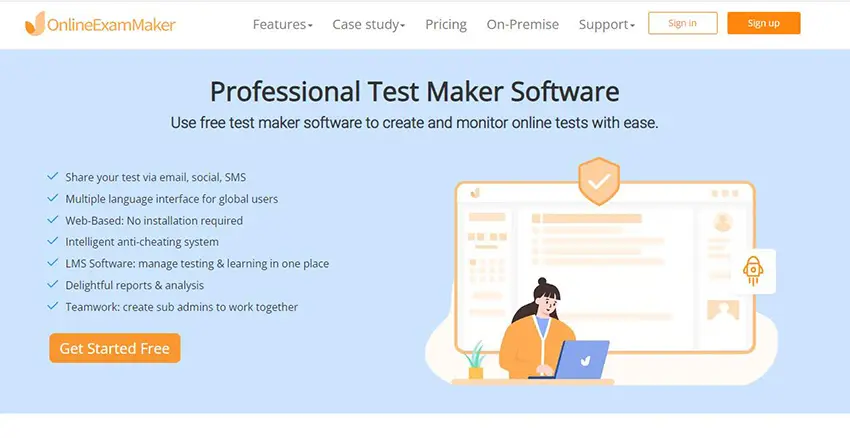
Capterra Rating: 5.0/5
Pricing: Free, no credit card required. Paid plans start from $32/month, $49/month for Professional plan, or $65/month for Premium plan.
Key Features:
• Provides automatic grading and results computation functionality when grading online exams.
• Supports various question types, such as multiple-choice questions, fill-in-the-blanks, and true/false.
• Detailed student performance analytics and reports.
• The feature ensures safe delivery of the exam through anti-cheating approaches
Who It’s For:
This is good software for educators who want a strong, user-friendly platform to help them through the process of grading that results from holding examinations online.
Why We Chose It:
OnlineExamMaker helps develop and grade an exam automatically, computing the results once a test has been taken. Grading manually will really be impractical, especially for very large classes. More than that, its support in secure delivery of exams and detailed analytics makes it the best for educators who want to reduce their workload and maintain exam integrity.
2. Turnitin Gradescope
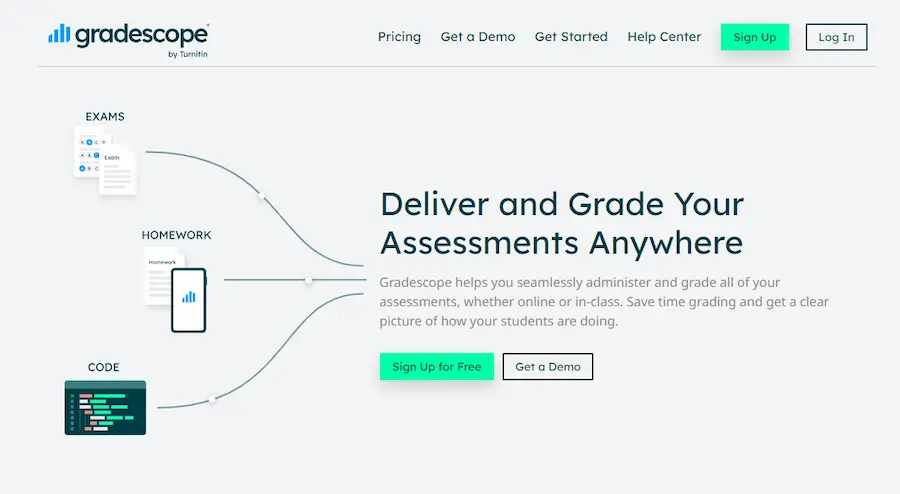
Capterra Rating: 4.5/5
Pricing: Free demo, custom pricing.
Key Features:
• Enable automatic grading of scanned and online assignments.
• Allow many question types, including handwritten responses.
• Easily integrated with Learning Management Systems, such as Canvas and Blackboard.
• Provides AI-powered grading suggestions that speed the process of grading.
Who It’s For:
Educators who have to grade digital and paper-based assignments quickly, especially within STEM courses.
Why We Picked It:
Gradescope is excellent when it comes to automating the grading of a wide range of different sorts of assessments, including anything that might be handwritten. Its AI-enabled grading paired with seamless integration with popular LMS platforms have cemented it as one of the top choices for all institutions to optimize grading efficiency while upholding academic rigor.
3. Canvas

Capterra Rating: 4.6/5
Pricing: Custom pricing.
Key Features:
• Has automatic quizzing and assignment grading.
• Allows for a variety of assessment formats, such as quizzes, discussions, and file uploads.
• Strong analytics and reports to track learners’ progress.
• Works with hundreds of third-party tools and applications in education.
Who It’s For:
Educational institutions that want an all-in-one LMS with automated grading among its many useful features.
Why We Picked It:
Canvas offers strong features to automate the grading of quizzes and assignments, allowing instructors to spend more time doing what they love: teaching. Its wide integration capabilities and powerful analytics make it a versatile solution that provides tracking on student progress and improvements on instructional strategies.
4. Moodle

Capterra Rating: 4.3/5
Pricing: Open source.
Key Features:
• Automatic grading of quizzes and activities inside the LMS.
• Supports essays, multiple choices, matching and more question types.
• Detailed gradebook and reporting tools to track performance.
• Features extensive customization of content and assessments for courses.
Who It’s For:
Educators and institutions that need a great degree of customization in an LMS but also need it to include automatic grading tools.
Why We Picked It:
Moodle is designed to be flexible and open source, allowing maximum customization; therefore, it’s favored when an institution needs specifically customized solutions. Its automatic grading for all sorts of assessments, along with gradebook features, enables teachers to get a lot more done by investing much less time on the business of marking.
5. Socrative

Capterra Rating: 4.4/5
Pricing: Free to use. Subscriptions range from $9.99 Per Seat/Month for Essentials plan, to $16.99 Per Seat/Month for Pro plan.
Key Features:
• Grading and providing formative feedback for quizzes and polls instantly.
• Types of question formats include MCQs, true and false, and short answer types.
• Real-time student engagement and formative assessment.
• Syncs data with popular LMS platforms.
Who It’s For:
The teacher who needs a quick, interactive way to gauge student performance with instant grading and feedback.
Why We Chose It:
Students can answer in real-time and it grades for you. This is an exceptional formative assessment tool that gives on-the-fly understanding of students to allow teachers to adjust instruction.
6. Edmodo
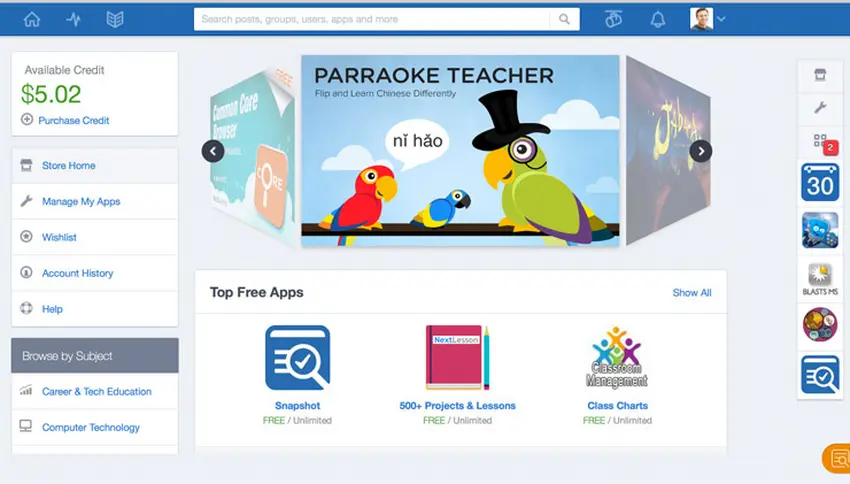
Uptodown Rating: 3.8/5
Pricing: Custom price quote.
Key Features:
• Auto-grading quizzes and assignments can be done.
• Be able to communicate clearly between teachers, students, and parents.
• Create collaborative areas of assignment and resource sharing.
• There is analytics and reports provision giving feedback on the progress made by students.
Who It’s For:
Educators seeking a platform that provides capabilities in social learning combined with functionality for automating assignment and quiz grading.
Why We Chose It:
Edmodo is chosen for the rather unique balance it strikes among social interaction and tools to learn, including automatic grading. The online exam tool working toward encouraging communication amongst teachers, students, and parents, in addition to its resource-sharing feature, makes it a strong option in keeping an environment within which learners are both engaged and collaborative.
7. Pearson MyLab

Capterra Rating: Null
Pricing: Custom.
Key Features:
• Provides automatic grading for online homework, quizzes, and exams.
• Supports personalized learning paths based on student performance.
• Integrates with various LMS platforms for easy grade synchronization.
• Offers detailed performance analytics to guide instruction and intervention.
Who It’s For:
Instructors who require a comprehensive platform for managing courses and automating the grading of homework and exams.
Why We Picked It:
Pearson MyLab is ideal for educators who want an integrated solution that automates grading and offers personalized learning paths for students. Its detailed analytics and seamless LMS integration make it a powerful tool for improving educational outcomes while reducing the grading burden on instructors.
8. ExamSoft

Capterra Rating: 3.8/5
Pricing: Free trial. Custom price quote for different requirements.
Key Features:
• Provides automated grading for both objective and subjective exam questions.
• Offers advanced security features like secure exam environments and proctoring tools.
• Allows detailed performance analysis with customizable reporting.
• Integrates with LMS and other educational tools for streamlined data management.
Who It’s For:
Institutions that conduct high-stakes exams and need a secure, automated grading system.
Why We Picked It:
ExamSoft is perfect for environments where exam security is crucial. Its ability to automatically grade both objective and subjective questions, along with its advanced security and reporting features, makes it a top choice for high-stakes testing scenarios.
How to Create An Automatic Grading Exam with OnlineExamMaker?
There are a few easy steps to follow when creating an auto-grading exam with OnlineExamMaker:
1. Register/Log In into the System
Register your account with OnlineExamMaker, or Log In if you have done that before. This will ensure that you can access all the functionalities of this platform.
Create Your Next Quiz/Exam with OnlineExamMaker
2. Create a New Exam
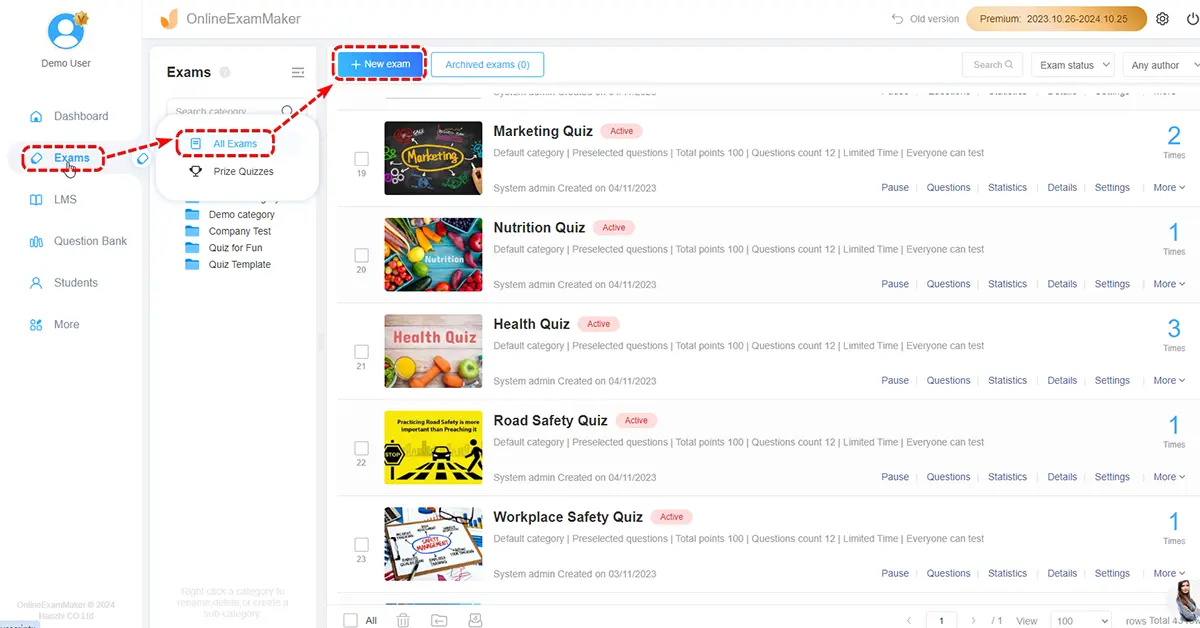
Click out in the dashboard, then click on the option for creating a new exam. The system will prompt you for such basic information as the name of the exam, description, and exam duration.
3. Design the Exam
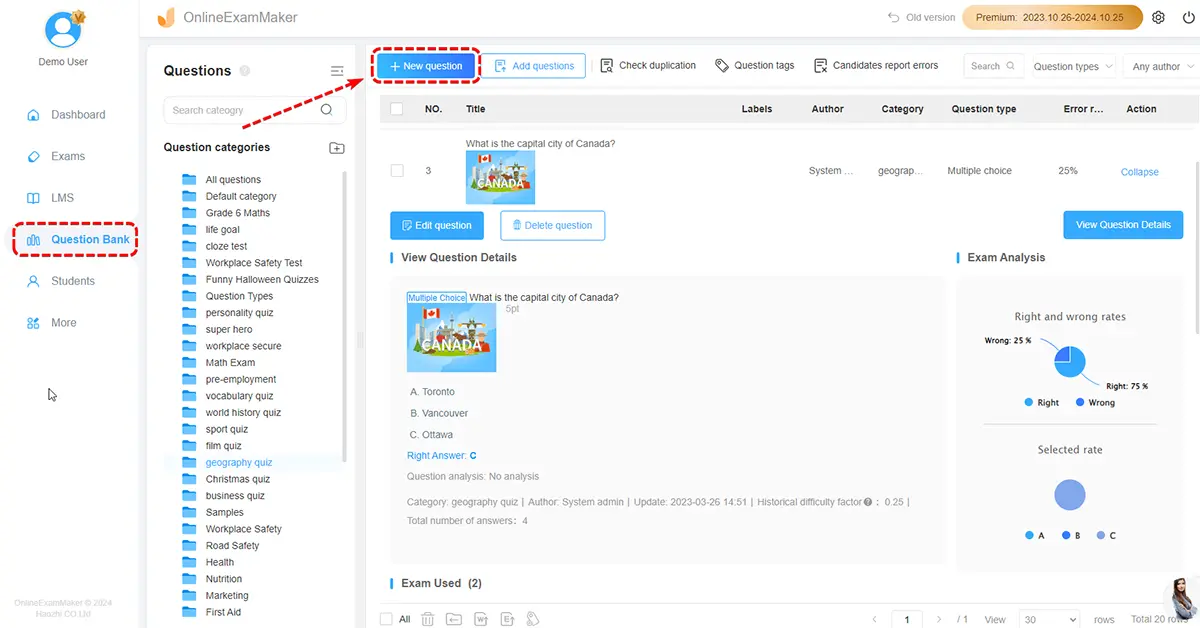
The option to add questions to your exam is made possible by sourcing from various types like multiple-choice, true/false, fill-in-the-blank, and short answer. OnlineExamMaker comes with easy-to-use input for questions and marking the correct answers. For multiple choice questions, you would put in the right answer along with the distractors.
4. Add Grading Rules
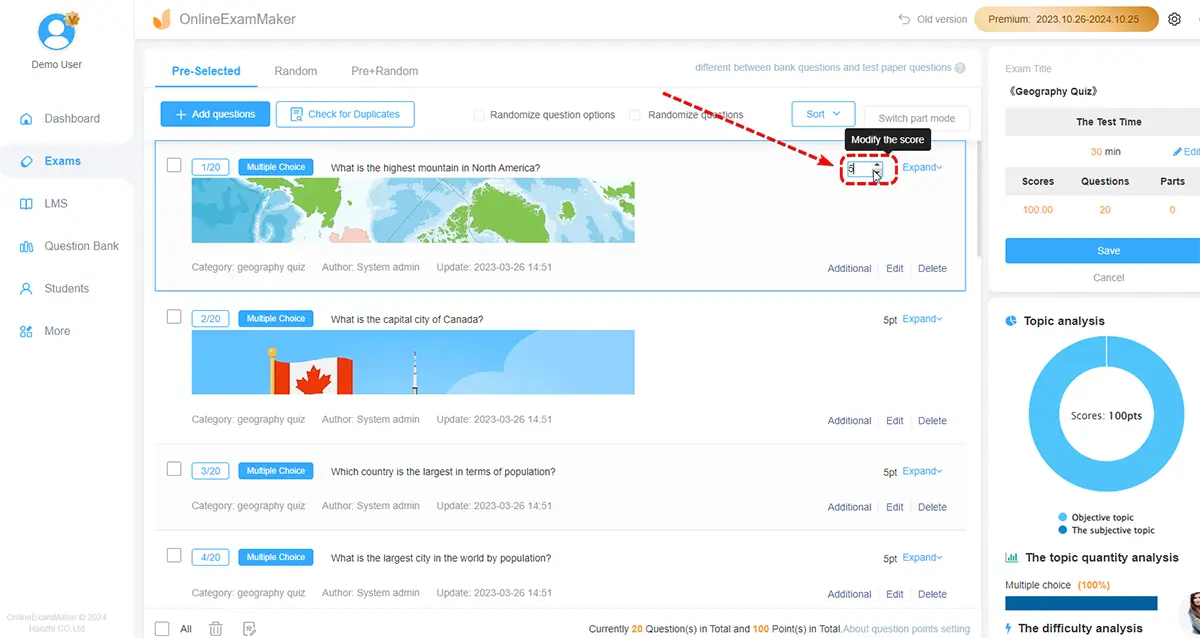
Set up the grading options for your exam. Determine the number of points each question is worth, and set any other additional grading rules like penalties for wrong answers or partial credit for partially correct responses.
5. Update Exam Settings
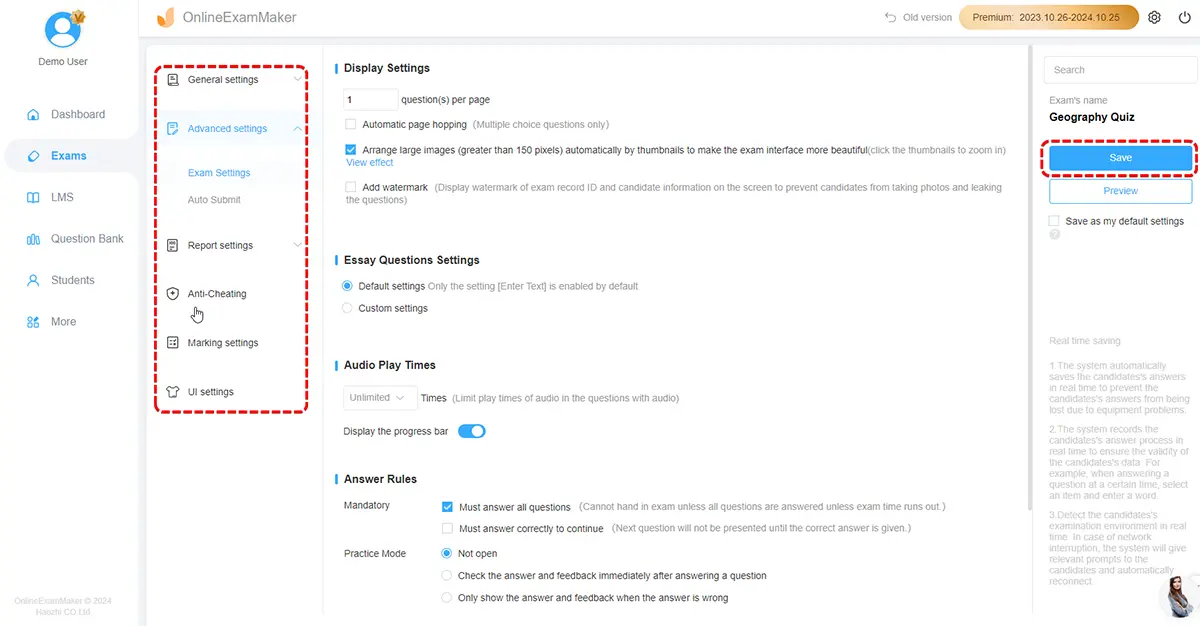
Make changes to settings that relate to how the exam looks and operates. You can also set rules for time limits, randomizing questions, and whether or not to allow students to be able to review their answers after submitting.
6. Preview and Test
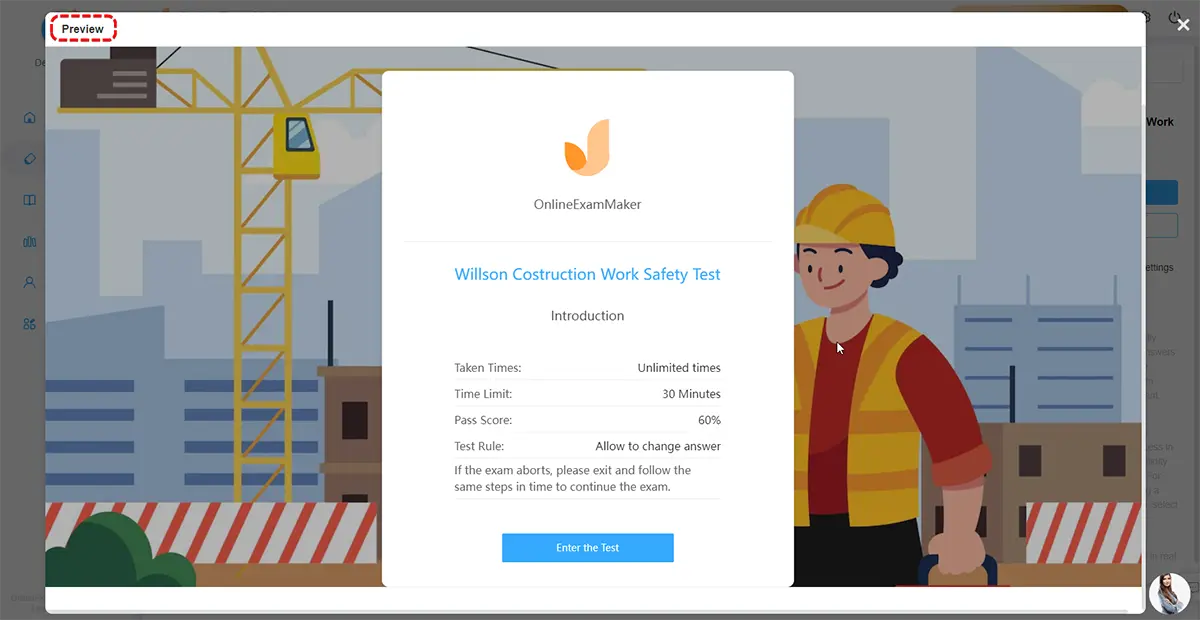
As you put final touches on the exam, go ahead and preview it to see the test as the student will see it. Test the exam to make sure the questions are formatted appropriately and that the automatic grading system is working properly.
7. Share the Exam
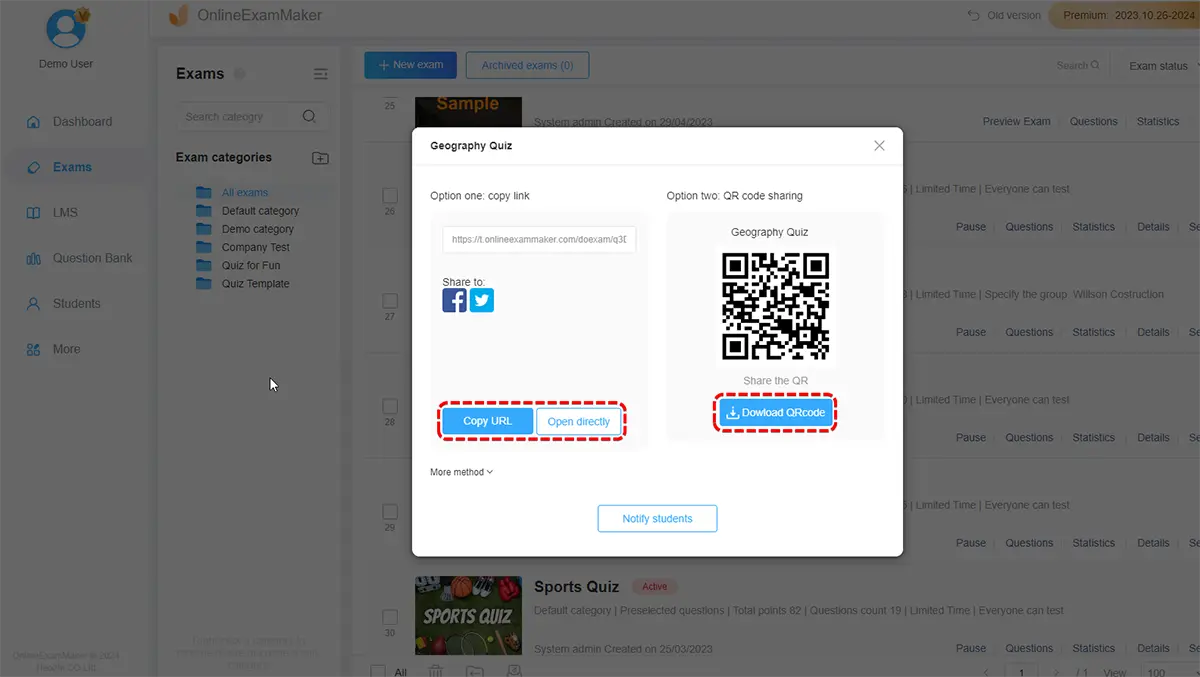
Once you’re done and content with the test, hit publish. OnlineExamMaker will produce a link or access code for students to attempt the test. You can share this with your students via email or through your learning management system.
8. Monitor and Review Results

After the student has taken the test, you can proceed to check his results at your OnlineExamMaker dashboard. This system will also grade examinations automatically based on the criteria you will set, and it will provide detailed analytics about the performance of students.